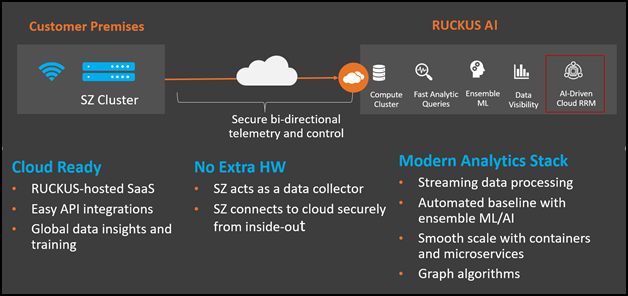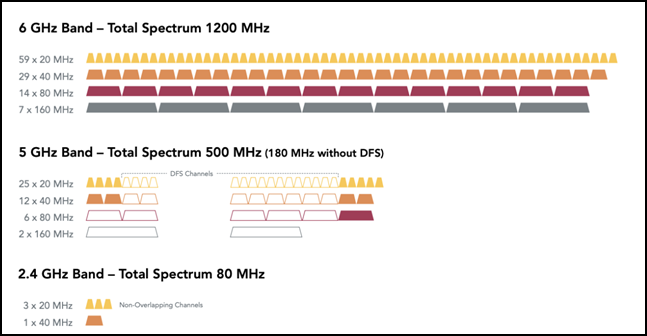AI-Driven RRM
AI-Driven Radio Resource Management (RRM) is a centralized algorithm that runs in the RUCKUS AI cloud and aims for least interfering links for the managed APs, whenever theoretically achievable, thus minimizing co-channel interference to the lowest level possible. This is accomplished by continuously gathering RF data from all the access points, holistically analyzing the RF environment and usage patterns, and jointly making optimal choices for channel re-use, channel bandwidth, and AP transmit power selection to maximize the network throughput. This new technology relies on sophisticated techniques of machine learning, artificial intelligence, graph algorithms, and cloud scale computation to jointly optimize channel, channel width, and AP transmit power. This method goes beyond adjusting the channel width because it optimizes across all combinations of channel, channel width, and AP transmit power to search for the optimal values across the network.

Like other AI features, AI-Driven RRM recommendations are available as an intent in the IntentAI page. When a new AI-Driven RRM recommendation is available, IntentAI allows you to choose your intent by specifying the network priority while applying the recommendation. For more information about the AI-Driven RRM intent, network priority and scope, refer to AI Feature-specific Intents, Network Priorities, and Scope.
Benefits of AI-Driven RRM for an End User
With the introduction of AI-Driven RRM, customer Wi-Fi client devices can expect to operate in interference-free RF conditions, when possible, and experience higher throughput and higher reliability with fewer retries and errors. This results in higher user satisfaction when connecting wirelessly to the network. Maximizing the channel bandwidth allocation in the interference-free environment also ensures optimal performance to support high-throughput and low-latency applications.
Advantages of AI-Driven RRM for a Network Administrator
While professional wireless engineers routinely optimize their network performance by selecting channel and power settings in addition to tuning other available configuration settings, this task is getting more difficult with the advent of the 6 GHz spectrum. A glance at the newly introduced spectrum and the available channel and channel width options make it tedious to manually optimize channel and channel width parameters required for a properly tuned Wi-Fi network. Not all enterprises have the wireless RF professionals available to tune these settings across the network. For a busy network administrator, sub-optimal conditions often go undiscovered until an end-user escalation.

With AI-Driven RRM, network conditions are continuously monitored in real-time. When a sub-optimal configuration is detected, the network administrator is presented with an optimized choice of channel and channel width in the form of an intent. With a single click, the administrator can apply the most optimal parameters to all the APs in a zone.
Once the intent is applied, IntentAI continues to autonomously monitor the network and applies an updated, AI-modeled channel plan when necessary. The changes are applied at the user-specified time. It is recommended to pick off-peak hours when the network is less busy to make the change to ensure minimal disruption. This automatic process continues indefinitely until the user chooses to revert or pause the intent. If the user chooses to pause the intent, all automation workflows are halted, and the network remains in its current state without triggering any configuration changes. During this paused state, KPI monitoring, ML model generation, recommendation updates, and configuration changes are suspended, ensuring no further adjustments occur until the intent is resumed. If reverted, the original configuration is restored.
Prerequisites for AI-Driven RRM
- AI-Driven RRM requires SmartZone controller release 5.2.1 and later. All access points supported on this release are compatible.
- The zone must be fully licensed.
- The zone must have at least two APs.
AI-Driven RRM Considerations
- When an AI-Driven RRM recommendation is applied, changes are made to RF parameters that overwrite previous configurations. If a ChannelFly configuration was previously selected for channel selection at the zone, the configuration moves under the control of AI-Driven RRM, and ChannelFly is disabled.
- The background scanning configuration and scanning interval is not changed but continues to operate collecting data to discover the RF neighborhood that is used for seamless roaming, rogue AP detection, and AI-Driven RRM algorithms.
- AI-Driven RRM will overwrite existing
static, manual configurations except
ApRadioDeployandChannelRange. If a static, manual configuration is detected, it is flagged in the recommendation itself with corresponding warnings. This allows the network administrator to decide whether to override the static, manual configuration by activating AI-Driven RRM. - AI-Driven RRM does not co-exist with manual override or intervention after the AI-Driven RRM recommendation is applied. The network administrator must disable AI-Driven RRM completely to have manual override for a subset of APs in a zone.
- AI-Driven RRM enables rogue detection at the zone level. This is done to gather a complete RF picture of the environment before optimization decisions are made.
- AI-Driven RRM recommendations are triggered only for zones with 100 percent licensed APs. Any unlicensed APs added to the zone after AI-Driven RRM is applied are not considered, which may result in sub-optimal channel planning in the zone.
- AI-Driven RRM does not operate when zones have active mesh APs.
- AI-Driven RRM requires SmartZone controller release 5.2.1 and later. All access points supported on this release are compatible.
- SmartZone controllers that are already onboarded to RUCKUS AI can immediately begin using AI-Driven RRM. For systems that are newly onboarded, AI-Driven RRM can be used immediately; however, the system improves in performance as historical information accumulates.
- AI-Driven
RRM recommends channel and channel width configuration items at the zone level. The
network administrator is required to pick a date and time to apply the configuration.
This is the local time for the zone for which recommendation is made. It is a best
practice to include access points in the same time zone in a SmartZone-managed zone node
because off-peak hours might differ across time zones.Note: If the RUCKUS AI license is removed or expired, the last run AI-Driven RRM configuration will be used, and the channel plan will be set to static and not ChannelFly or Background Scanning.
AI-Driven RRM Behavior in 2.4 GHz
It is generally accepted and understood that 2.4 GHz is a crowded spectrum with only three non-overlapping channels. However, it is important because several clients still support only the 2.4 GHz band. RF propagation characteristics unique to 2.4 GHz make it a useful choice due to its increased range.
Since the 2.4 GHz band has only three non-overlapping channels (1, 6, and 11), it is likely that APs in this band will hear other APs, and a "zero interfering links" solution does not exist in dense AP deployments in 2.4 GHz. In this scenario, AI-Driven RRM will still aim for the lowest possible co-channel interference. It does not take action to turn off AP radios in the 2.4 GHz band.
AI-Driven RRM with Dynamic Frequency Selection Channels
AI-Driven RRM is aware of the constraints that Dynamic Frequency Selection (DFS) channels pose in 5 GHz spectrum usage. While the actual decision to operate in a DFS channel is still done at an AP radio level after radar detection measures have been applied, AI-Driven RRM keeps track of radar activity on different DFS channels and intelligently crowdsources this information across multiple APs within the same physical proximity. Based on this crowdsourced information, AI-Driven RRM may restrict the use of some of these DFS channels to avoid disruptions to end users. Of course, optimality in terms of zero interfering links and channel bandwidth selection will still be maintained.
AI-Driven RRM Operation at Zone and AP Levels

AI-Driven RRM Interoperability in a Mixed AP Deployment
The AI-Driven RRM algorithm works on the information it receives from RUCKUS access points. Any third-party access point is treated as a rogue AP. These data points are fed into the computation to search for the best option for channel and channel width. These changes are recommended to the network administrator using the AI recommendation mechanism. There is no deauthentication action taken against rogue APs because the algorithms have built-in rogue AP avoidance. Even in the presence of rogue access points or third-party access points, AI-Driven RRM delivers the most optimum solution for interfering AP links and co-channel interference possible.
AI-Driven RRM AP Transmit Power
In high-density deployment scenarios, an ideal channel plan with no interfering links may not be achievable. To address this, AI-Driven RRM automatically detects the residual co-channel interference and provides recommendations for further reducing the interference by lowering the AP transmit power, while at the same time, ensuring that no coverage holes will be created. This minimizes the possibility of neighboring APs interfering with each other's signals, resulting in an enhanced Wi-Fi end-user experience.
AI-Driven RRM with Automated Frequency Coordination
AI-Driven RRM is enhanced with configuration from Automated Frequency Coordination (AFC) for 6 GHz channel allocation in the US region.
AFC is a system designed to manage spectrum use in the 6 GHz band, maximizing spectrum access and minimizing interference between unlicensed Wi-Fi 6E/7 devices and licensed devices. AFC involves a registered database that contains information about all licensed users currently operating in the 6 GHz band in a specific area. When a new Wi-Fi device, such as an AP, wants to operate in the 6 GHz band, it must register with the AFC system, and thereafter must check in with the system every 24 hours, to obtain a current list of available channels on which to operate. These periodic checks ensure its operation will not interfere with registered devices already using that band. Standard power APs, especially when used outdoors, have a higher potential to interfere with existing 6 GHz users. Therefore, these APs must use the AFC system to protect incumbent operations from RF interference. The AFC system is crucial for maintaining harmony in the spectrum usage, allowing new and existing technologies to coexist without disrupting each other’s services. Without AFC registration, indoor APs operate in low power mode and outdoor APs cannot operate in the 6 GHz spectrum at all.
AI-Driven RRM solves this by integrating AFC (based on AFC’s channel list) to provide better optimized network configurations. When the channel list is selected for RRM, instead of using only the channels defined in the SmartZone controller, RRM will consider the AFC response data from the APs and compare the AFC channel list with the controller-configured channels. The overlapping or common channels identified through this comparison will be utilized to provide an optimized configuration recommendation.
Considerations for AI-Driven RRM with AFC
- AI-Driven RRM recommendation must be in the Applied state.
- AI-Driven RRM based on AFC is applicable only to the US region.
- AFC is required for indoor and outdoor 6-GHz APs running in Standard Power mode.
IntentAI: AI-Driven Radio Resource Management. This video provides an introduction to AI-Driven RRM intent and demonstrates how to optimize the network using AI-recommended configurations to reduce interference and improve performance.